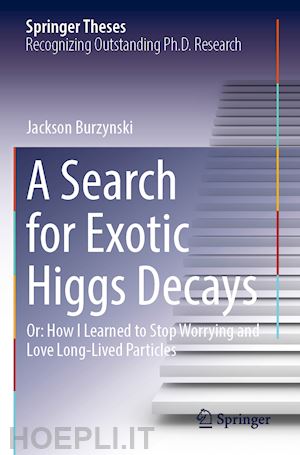
Questo prodotto usufruisce delle SPEDIZIONI GRATIS
selezionando l'opzione Corriere Veloce in fase di ordine.
Pagabile anche con Carta della cultura giovani e del merito, 18App Bonus Cultura e Carta del Docente
This work describes a search for exotic decays of the Higgs boson to two long-lived, neutral, spin-0 particles which subsequently decay to pairs of b quarks, giving the striking signature of displaced hadronic jets in the ATLAS inner detector. Several other ATLAS searches have probed this decay topology previously, excluding branching ratios of the Higgs boson to LLPs of more than 10% for proper lifetimes greater than 100mm. These searches relied on dedicated triggers designed to select events with LLPs decaying in the ATLAS calorimeter or muon spectrometer. The lack of an equivalent trigger for LLP decays in the ATLAS inner detector has been a limiting factor in probing LLP lifetimes less than 100mm. To circumvent the difficulty of triggering on LLP decays, the search presented in this thesis exploits the ZH associated production mode, relying on leptonic trigger signatures to select interesting events. This is the first search for Higgs boson decays into LLPs to exploit this analysis methodology and additionally makes use of several novel methods for both background rejection and background estimation.
No excess over Standard Model predictions is observed, and upper limits are set on the branching ratio of the Higgs boson to LLPs . Depending on the mass of the LLP, branching ratios greater than 10% are excluded for lifetimes as small as 4mm and as large as 100mm, probing an important gap in the ATLAS exotic Higgs decay programme. In comparison to the previous searches for Higgs decays to LLPs, these are among the most stringent limits placed on this scenario, and for LLPs with masses below 40 GeV these results represent the strongest existing constraints on the branching ratio of the Higgs boson to LLPs in this lifetime regime.
Jackson Burzynski is a high energy particle physicist working on the ATLAS experiment at CERN. His research is centered around searches for new physics with unconventional detector signatures, such as those originating from the decays of metastable particles that travel considerable distances through the ATLAS detector before decaying.
In addition to performing fundamental research, Jackson also works to study and improve the algorithms used by the ATLAS experiment to reconstruct charged particle trajectories. He played a crucial role in the optimization of the algorithm used to search for charged particles produced at large radii which helped to revolutionize the long-lived particle search programme in ATLAS. He is also passionate about analysis software and efficient data pipelines, and is working to streamline and improve the way that physics analysis at the LHC is performed.
Jackson received his PhD from the University of Massachusetts Amherst under the supervision of Benjamin Brau. He currently holds a postdoctoral research fellow position at Simon Fraser University.











Il sito utilizza cookie ed altri strumenti di tracciamento che raccolgono informazioni dal dispositivo dell’utente. Oltre ai cookie tecnici ed analitici aggregati, strettamente necessari per il funzionamento di questo sito web, previo consenso dell’utente possono essere installati cookie di profilazione e marketing e cookie dei social media. Cliccando su “Accetto tutti i cookie” saranno attivate tutte le categorie di cookie. Per accettare solo deterninate categorie di cookie, cliccare invece su “Impostazioni cookie”. Chiudendo il banner o continuando a navigare saranno installati solo cookie tecnici. Per maggiori dettagli, consultare la Cookie Policy.